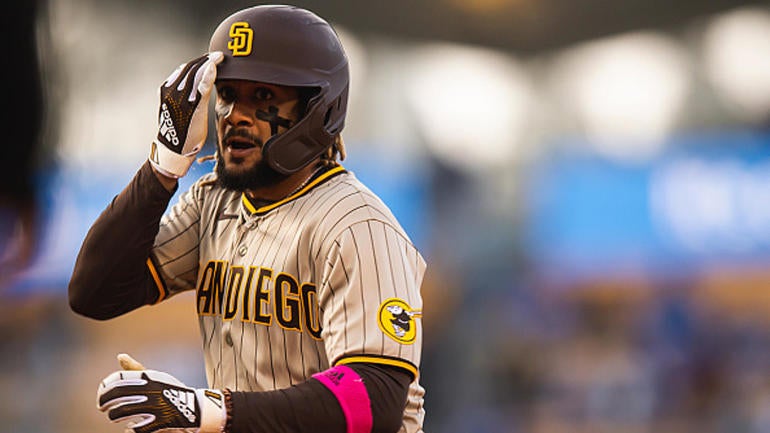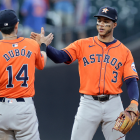
The subject of stealing signs in Major League Baseball has once again come to the forefront this week, and I can't help but wonder if a good number of people need a refresher on what kinds of stealing are acceptable and simply just part of the game, and what kinds of sign stealing are not acceptable. Further, I can't help but wonder if we're collectively getting too sucked in to catching things on video in slow motion.
Twice within the last week, there's been at least mild controversy made over the matter of sign stealing that leads me to believe we could take a collective breath here. Let's review the instances:
- Saturday, Padres wunderkind Fernando Tatis Jr. took Dodgers starter Trevor Bauer deep. A bit later, some 2021-version Zapruder-like footage emerged of Tatis possibly glancing back toward catcher Will Smith's signs. Bauer tweeted about it. It went viral, and drew the ire of many fans. A column in the LA Times brought up the 2017 Astros and said the Dodgers, "once again had been robbed, embarrassed and played for fools." Bauer didn't take kindly to the possibility that Tatis was peeking. Dodgers manager Dave Roberts said, via dodgers.com, "when you talk about peeking, that's just not the way you play baseball. If that is the case, which I don't know, that'll be noted."
- Monday, Tigers legend Miguel Cabrera said the White Sox were accusing them of relaying signs from second base. He was none too happy. Here are Cabrera's comments, via freep.com: "It was the second baseman because he tried to tell the catcher and the pitcher we passed the sign. I mean, come on, that's some (expletive). I don't play that game. You need to respect. You don't need to show up me or somebody or the runner on second, trying to say we passed the sign from second. Come on, get the (expletive) out of here. That's not right."
In taking the brief description of both instances into consideration, it tells me that the sport hasn't completely healed since the 2017 Astros and, to a lesser extent, the 2018 Red Sox were both caught electronically sign stealing. These were sign-stealing scandals involving back-to-back World Series champions. Legions of casual fans found out there was cheating done by the champions and hear the word "stealing" in there. That must mean all sign stealing is bad, right?
From Roberts' perspective on Tatis, well, it was his Dodgers losing the World Series in both 2017 and 2018. Who can blame him for taking it seriously?
Also consider that Cabrera's current manager is A.J. Hinch, who was the Astros' manager in 2017, and you can't help but wonder how much paranoia is sweeping the game.
Again, I feel like a lot of this stems from the recent scandals. So let's discuss three forms of sign stealing and their role in the game:
Using electronics
Electronic sign stealing is illegal and cheating and should never happen again. It shouldn't have happened in the first place. We should point out there's a long history of players trying to cheat like this and it goes back decades (search the 1960s White Sox for one example). It's not just the 2017 Astros. Hopefully they were a turning point, though, and we're done with it for good. I'm not naïve enough to believe that'll actually happen, but a man can hope. Hope is a good thing.
Peeking back at the catcher from the batter's box
This is perfectly legal, but it's also long been established as a Bush League move that just isn't done. In old-school baseball mentality, it's long been grounds for taking a pitch to the ribcage. Regardless of one's feelings on dotting players on purpose, pretty much everyone involved in the game agrees that looking back at the catcher is 1) legal; 2) something you aren't supposed to do.
On the Tatis play in question, though, I'm not sure he did. The Padres have said he didn't peek back. The tweet posted on it shows it in super slow motion and he barely looks down for an instant about a split second before Bauer threw the pitch. For me, I just don't think he had enough time to process that he saw a sign and knew what pitch was coming in time to hit a home run. Even if he saw location, Bauer missed his spot. Watch where Smith's glove is versus where the pitch ends up:
Smith wanted that around the middle of the plate at the bottom of the zone. Tatis hit it almost belt high and six inches outside. In fact, I'd argue he absolutely did not know what pitch was coming because he started his swing early and pulled an outside pitch, suggesting he reacted at first as if it were a fastball and was able to adjust on the fly.
If I'm wrong and Tatis did look back and get the sign, I agree that it's bad and he should be shamed. I just don't think he did.
My hunch is the 2017 Astros paranoia is sweeping the Internet and people are ready to find little quirks like this and run with them.
A baserunner relays signs to the batter
I love Miguel Cabrera and he's long been a great baseball mind. I'm just going to assume he got caught up in similar paranoia around having Hinch as his manager and is worried about any public backlash due to that scandal, because there is absolutely nothing wrong at all for a baserunner to relay signs to the hitter. It's legal and it's always been an accepted part of the game. That's why signs are changed, why a catcher will flash at least three signs using an "indicator" with a runner on second and there are cards with different sets of signs used (you'll see a pitcher glance into his hat every once in a while on a broadcast; he is checking which set of signs they are using).
This isn't even remotely controversial. It starts in youth baseball. No, not necessarily Little League, but anyone who played in their teens knows it's part of the game. In high school, catchers were expected to know how to shield the runners on first and/or third from seeing any dangling fingers while a series of signs with an indicator were used with a runner on second. It was never viewed as anything except a part of the game.
If a runner on the bases figures things out in the majors, though? That's bad. It's a bad job by the pitching team.
"That's the catcher's and pitcher's fault," said a former MLB player who is now a scout. "Change the signs."
"If the hitter knows what is coming and it came from the runner on second, that's our fault," said a former MLB pitcher. "We have to do a better job with the signs."
"It's totally fair game," a former pitcher and current scout added. "Game within the game."
This isn't just a case where it's acceptable for the baserunner to relay any signs he figures out. It's actually encouraged. If the pitcher and/or catcher are this reckless with their signage, they need to be punished on the scoreboard. There's a reason there are signs in the first place. By design, using them is to keep your plan of attack secret from the other side.
If a team can discover said plan of attack simply by paying attention on the bases with the naked eye, more power to them. Using technology or peeking back from the batter's box? Nope.
That's where the line is in Major League Baseball with regard to sign "stealing."


















